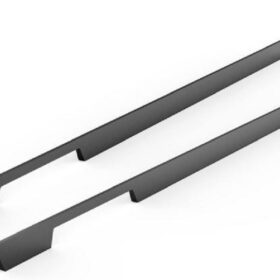Safety Features of Edge Handle Profiles
Edge handle profiles are an essential part of many industrial and commercial applications, providing a convenient and ergonomic way to grip and manipulate heavy or awkward objects. However, it is crucial to ensure that these profiles are designed with safety in mind to prevent accidents and injuries. This article explores the key safety features of edge handle profiles, highlighting how they contribute to a safer work environment.
Slip Resistance
One of the primary safety features of edge handle profiles is slip resistance. This refers to the ability of the profile surface to provide sufficient friction to prevent users from losing their grip, even in wet or slippery conditions. Slip-resistant surfaces typically feature a combination of textures and materials, such as knurled patterns or rubber inserts, that enhance friction and prevent hands from sliding off the handle.
Edge Protection
Edge handle profiles often have sharp or exposed edges that can pose a laceration or puncture risk to users. To mitigate this risk, profiles are designed with rounded or recessed edges that eliminate sharp points and reduce the likelihood of contact injuries. Recessed edges also help prevent snagging or tearing of clothing or gloves, further enhancing user safety.
Ergonomic Design
Ergonomic design plays a vital role in the safety and comfort of edge handle profiles. Profiles are contoured to fit the natural shape of the hand, reducing strain and fatigue during extended use. This reduces the risk of repetitive motion injuries, such as tendonitis or carpal tunnel syndrome, which can occur from prolonged use of poorly designed handles.
High-Visibility Colors
High-visibility colors are another important safety feature of edge handle profiles. By using bright or contrasting colors, profiles can be easily seen and identified in dimly lit or cluttered environments. This helps prevent accidental collisions or mishandling of objects, reducing the risk of injuries or equipment damage.
Strength and Durability
The strength and durability of edge handle profiles are critical to ensuring user safety. Profiles must be able to withstand the loads and forces encountered during typical use without breaking or deforming. High-quality profiles are manufactured from robust materials, such as steel or aluminum, which provide excellent strength-to-weight ratios and resistance to wear and tear.
Compliance with Standards
In addition to the aforementioned safety features, edge handle profiles must comply with applicable safety standards and regulations. This ensures that profiles meet the minimum safety requirements set forth by industry or government authorities. Compliance with standards also provides assurance that profiles have been independently tested and validated for safety and performance.
By incorporating these safety features into edge handle profiles, manufacturers can help reduce the risk of accidents and injuries in the workplace. These profiles not only enhance the convenience and ergonomics of handling heavy objects but also prioritize the safety of users, creating a safer and more efficient work environment.
-
2024-11-29Top Trends in Modern Kitchen Cabinet Pulls for 2024
-
2024-11-28The Ultimate Guide to Modern Kitchen Cabinet Pulls- Materials, Styles, and Tips
-
2024-11-27Elevate Your Kitchen Design with These Must-Have Modern Cabinet Pulls
-
2024-11-26Sleek and Stylish- The Best Modern Kitchen Cabinet Pulls for a Contemporary Look










